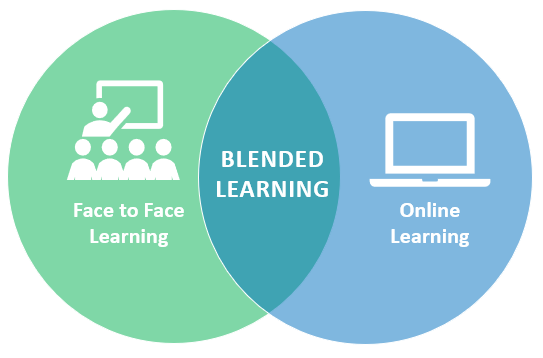Blended learning is a successful combination of e-Learning, traditional classroom and autonomous study. It’s been gaining popularity in recent years, in response to amazing proliferation of online learning, on the one hand, and consistently strong positions of traditional school, on the other hand. Some might think of blended learning as a trade-off or yet another version of the Buridan’s ass paradox. Indeed, neglecting the fact that we live in the 21st century has been a definitive showstopper for a multitude of great initiatives. That said, disrupting the battle-hardened educational system with its solid methodology, academic backup, strong instructor figures, and developed intellectual and psychological bonds, is hardly a wise thing to do.
Just to be clear, I’m an eager proponent of blended learning. In my opinion, the pros of this approach firmly outweigh the cons, if we are putting the issue into perspective. The advantages include:
- Advanced collaboration tools. Online discussions, quick messages and feedback from the instructor and peer students.
- Increased accessibility. Courses can be accessed 24/7 – any time from any location.
- Improved communication. Better connection between lecturers and part-time students.
- Assessment 2.0. Facilitated student evaluations with comprehensive online testing and granular reporting. Automatic grading offered by many learning systems is also a great relief for the teacher.
- Personal approach. Caters to each student’s pace and learning style, creates a more comfortable environment for both slow runners and sprinters. If the learners are struggling with a particular topic, they can reach out to complementary web resources or get quick help from their instructor.
- It’s just fun! Blended learning courses have proven to be more engaging for various student groups – from elementary school to post-graduates and advanced trainees.
However, for the sake of fairness this article focuses on the disadvantages of blended learning. Increased cognitive load, steep learning curve for conservative teachers, lack of direct supervision… Let’s take a look at the cons suggested by the e-Learning community.
1. The technology challenge. Infrastructure
There are at least two angles to this problem. The first is building the essential infrastructure within an educational institution or particular class. Does the facility have the required IT workforce? Can it allocate the right budget, or does it, in fact, reveal any willingness to shell out on an experimental case?
Acquiring software technology and hardware for your blended learning program can be costly. Even more so if you are dealing with a large campus or multiple branches. However, there is a long-term silver lining to it. By investing into the right tech set today, you are probably saving loads of cash that would otherwise be spent on supporting an obsolete brick-and-mortar framework.
2. The technology challenge. Mentality
The tech resources employed in blended learning need to be reliable, easy to use and unanimously accepted by all stakeholders of the learning process. Otherwise, the initiative will most likely be gathering dust until some remote milestone is reached.
The other issue is IT literacy, which may be a significant barrier for teachers rather than students. The availability of solid tech support and trainers is an absolute must. It’s also important to nurture a blended learning community to evangelize the value of training technology. Any hiccups and lack of organization may bring along the looming danger of failure. Old school supporters always have an ace up their sleeve: a long track record and verified methodology. Innovators really have to go the extra mile to convince the hesitant and reveal the benefits rather than disadvantages of blended learning.
3. Pace of advancement
What primarily looks like an upside turns into a downside when you come to review specific learning scenarios. For example, the use of lecture recording may actually result in learners lagging behind on the course flow. Some students may choose to linger around for a while and then watch a bunch of video classes in one sitting, while others would rather make the interactive class part of their daily/weekly routine. At the end of the day, an instructor trying to sync up both streams with ongoing offline activity is faced with a daunting task.
4. Negative impact on teachers. Overwork
It’s hard to disagree that there’s a significant amount of extra teacher’s work involved in the primary stages. Paradigm shift is not exactly a trifle. A teacher adopting blended learning has to pick the right syllabus, the right ratio between face-to-face and online learning, and to the best of my knowledge, there’s no universal recipe to it. The WebQuest model might be worth checking out, as a sample of successful ‘hybridization’. Also, technical training is key. The broader your horizons, the easier to find a best-fitting solution.
5. Negative impact on students. Cognitive load
The first thing that comes to mind when you think of the disadvantages of blended learning is the cognitive load. New to the blended model, some teachers may start overdelivering content and educational activities. The new program may become a friend if tailored to individual student needs, and a foe if applied in bulk, as is usually the case with traditional classroom learning. On the bright side, the instructor now has tools to engage and motivate students in the 21st century fashion, using interactive elements, gamification, digital certification, etc.
6. The plagiarism and credibility problem
Naturally, once your class is officially Internet-friendly, it’s hard to withstand the temptation of looking up things on the web or getting instant tips from fellow students. This may affect fair assessment and quality of course work. Besides, the teacher needs to make learners aware of the perils of unverified online resources, such as bias, distortion and misrepresentation of facts.
In conclusion
Every learning methodology has its pros and cons. As always, you need to measure your requirements against existing options. Will the combination of e-Learning technology with face-to-face instruction and self-paced training benefit your audience? Do the rewards outweigh the risks? Are your students ready to embrace the new way of thinking and learning? An unrestrained and versatile educational environment may be an invaluable motivational factor for some, and a source of cognitive dissonance for others.
Disadvantages of blended learning exist but they are not unsurpassable. The negative impact can be minimized or even channeled into productive activity if the instructor keeps an eye on student feedback, improves technology skills and delivers quality courses. Besides, some benchmarking would never hurt in this complex field. Look around, your colleagues may have already cut their teeth on blended learning, so they can give you a few pointers. That said, every experience is unique and can hardly be duplicated under different conditions.
*This article was wrote by Scott Winstead and published in https://myelearningworld.com/6-disadvantages-of-blended-learning/


